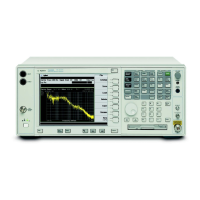Chapter 3 93
Making Measurements
PM Deviation Measurement
PM Deviation Measurement
This procedure describes how to make a PM Deviation measurement. In this
measurement example, a signal generator is the UUT and is adjusted to deliver a
test signal. PM Deviation measurements are used to measure and display the phase
deviation of the modulation on the signal.
The measurement results are:
PM Deviation
Mod Rate
Mod Distortion
Mod SINAD
Measurement Procedure
Step 1. Setup the measurement system. See “System Hardware Connections” on page 44.
The power meter and N5532A/B Sensor Module are not used. Connect the signal
generator output to the PSA RF input.
Step 2. Adjust the signal generator for the desired settings for your test. Refer to the text of
Figure 3-13 for example settings.
Step 3. Configure the measuring receiver. On the PSA press
Mode, select Measuring
Receiver
, Measure, PM Deviation.
Step 4. On the PSA, press
Frequency and enter the carrier frequency.
NOTE The measuring receiver Frequency Counter measurement can be used to measure
and set the carrier frequency on the PSA if the modulation on the source is turned
OFF.
Modulation must be turned off for modulated signals since the modulation may
distort the signal spectrum and cause error when using the frequency counter
function.
Step 5. Press
Restart.
NOTE Pressing Restart optimizes the measuring receiver configuration, and is very
important when changes to the measuring receiver settings or the UUT are made.
Pressing
Restart causes the measuring receiver to determine if the PSA settings are
correct for the incoming signal, and if they are not, slight changes are made.

